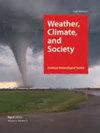You Have to Send the Right Message: Examining the Influence of Protective Action Guidance on Message Perception Outcomes across Prior Hazard Warning Experience to Three Hazards
IF 1.9
4区 地球科学
Q3 ENVIRONMENTAL STUDIES
引用次数: 1
Abstract
A long-term goal for warning message designers is to determine the most effective type of message that can instruct individuals to act quickly and prevent loss of life and/or injury when faced with an imminent threat. One likely way to increase an individual’s behavioral intent to act when they are faced with risk information is to provide protective action information or guidance. This study investigated participant perceptions (understanding, believing, personalizing, deciding, milling, self-efficacy, and response-efficacy) in response to the National Weather Service’s experimental product Twitter messages for three hazard types (tornado, snow squall, dust storm), with each message varying by inclusion and presentation of protective action information placed in the tweet text and the visual graphic. We also examine the role of prior hazard warning experience on message perception outcomes. To examine the effects, the experiment used a between-subjects design where participants were randomly assigned to one hazard type and received one of four warning messages. Participants then took a post-test measuring message perceptions, efficacy levels, prior hazard warning experience, and demographics. The results showed that for each hazard and prior hazard experience level, messages with protective action guidance in both the text and graphic increase their understanding, belief, ability to decide, self-, and response-efficacy. These results reinforce the idea that well-designed messages, that include protective action guidance, work well regardless of hazard type or hazard warning experience.你必须发送正确的信息:检查保护行动指南对先前三种危险的危险警告经验中信息感知结果的影响
警告消息设计者的长期目标是确定最有效的消息类型,以指导个人在面临迫在眉睫的威胁时迅速采取行动,防止生命损失和/或受伤。当个人面临风险信息时,增加其行为意图的一种可能方法是提供保护性行动信息或指导。这项研究调查了参与者对美国国家气象局实验产品推特上三种危险类型(龙卷风、暴风雪、沙尘暴)的反应感知(理解、相信、个性化、决定、磨磨蹭蹭、自我效能和反应效能),每条消息因包含和呈现推文文本和视觉图形中的保护动作信息而变化。我们还研究了先前的危险警告经验对信息感知结果的作用。为了检验影响,实验采用了受试者之间的设计,参与者被随机分配到一种危险类型,并收到四条警告信息中的一条。然后,参与者进行了一项事后测试,测量信息感知、疗效水平、先前的危险警告经历和人口统计数据。结果表明,对于每种危险和先前的危险体验水平,文本和图形中带有保护行动指导的信息都能提高他们的理解力、信念、决策能力、自我和反应效能。这些结果强化了这样一种观点,即无论危险类型或危险警告经验如何,精心设计的信息,包括保护行动指南,都能很好地发挥作用。
本文章由计算机程序翻译,如有差异,请以英文原文为准。
求助全文
约1分钟内获得全文
求助全文
来源期刊

Weather Climate and Society
METEOROLOGY & ATMOSPHERIC SCIENCES-
CiteScore
3.40
自引率
13.60%
发文量
95
审稿时长
>12 weeks
期刊介绍:
Weather, Climate, and Society (WCAS) publishes research that encompasses economics, policy analysis, political science, history, and institutional, social, and behavioral scholarship relating to weather and climate, including climate change. Contributions must include original social science research, evidence-based analysis, and relevance to the interactions of weather and climate with society.
 求助内容:
求助内容: 应助结果提醒方式:
应助结果提醒方式:


